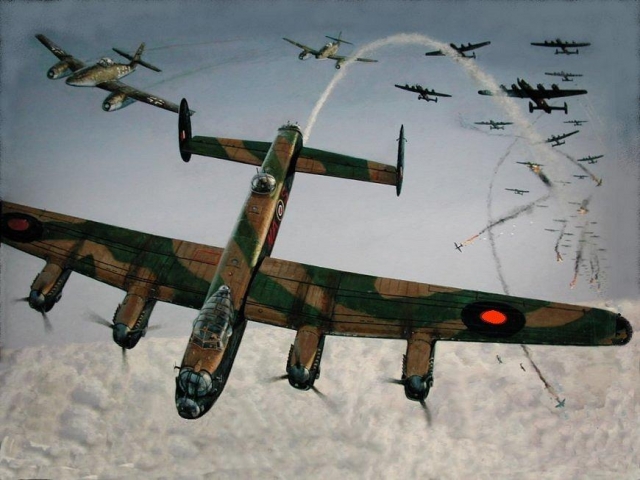Second World War
Artifact W2-08: Memories of a Bombing Run
Written by: Ken Cownley for Sandy Mutch

Sandy returned to the UK in early 1944 after flight training in Canada and was posted to 428 (Ghost) squadron at Middleton St.George in January 1945. Initially flying only at night, members of 428 Squadron were harried by German night fighters, searchlights and anti-aircraft gunfire (flak) and the very real fear of collisions with ‘friendlies’. By March 20, Bomber Command switched to daylight raids during which the formation leader would trail smoke that led to the target. The Canadians flew as a ‘gaggle’ which was an imprecise formation that in no way resembled the US 8th Air force precision formations. However, flying in daylight was far easier than night flying!
The crews would often see large formations of Fortresses and Liberators flying at the same altitude. Many medium bombers were also clearly visible but few allied fighters were seen since those on ground sweeps were too low to see while those on escort duty were often too high.
The crews could also see the puffs of smoke from flak, or ‘scarecrows’ which were exploding bombers hit in the bomb bay before dropping their load. They also knew that very few crews were able to bail out of crippled aircraft. At times their flight paths crossed the American’s which required course corrections to avoid collisions. Sometimes these corrections were made based on lining up the approaching aircraft with a speck of dirt on the windshield; if it didn’t move – you did!
On 31 March 1945 Sandy’s crew was chosen as the navigational lead crew and deputy leader of the ‘gaggle’. The overall group consisted of 361 Lancasters, 100 Halifaxs and 8 Mosquitoes as Pathfinders. Joined by a fighter group of 134 Mustangs and 47 Spitfires over Holland, this was a maximum effort raid to destroy the Blohm and Voss U-boat yards. In total there were more than 1500 Canadians in the attack.
The bomb group was airborne by 0615 and things were ‘normal’ until about 2 hours out when the lead aircraft dropped out and told Sandy to take over. Losing time the group pressed on to their target all the while knowing that as the last group they would bear the brunt of the fighter and ground flak attack. Arriving at the target 10 minutes late the smoke markers dropped by the Pathfinders were of little or no use so the decision was made to bomb the smoke cloud from the previous attacks. At this point “all hell broke loose” as the ‘gaggle’ came under attack by German jet fighters. A summary of the engagement taken from “The RCAF Overseas – The Sixth Year” pages 152-156 describes the action:
“The last group – ten minutes late – did not get under the planned fighter umbrella”
“For four or five minutes, they were hotly engaged – in all there were 78 encounters and 28 crew reported one or more combats with the pack of jets”
“Our losses however would have been much higher had it not been for the timely arrival of some RAF Mustangs that turned back to investigate the aircraft flying far in the rear of the main force.”
Finally Sandy’s aircraft was attacked which he avoided by pushing the stick forward into a negative G ‘bunt’ which was a prohibited maneuver for the Lancaster. The Navigator, Bomb aimer and Flight engineer all “took wing” and found themselves on the ceiling of the aircraft, while 2 Me262s shot by above the aircraft within less than a wing’s length!
Pulling back on the stick, gravity robbed the aircrew of their new-found ability to fly as they fell down into the bomb aimer’s turret where they were ‘nailed down’ by the effects of positive G. The crew struggled back to their position while the aircraft bounced back into the lead position.
The rest of the flight home was ‘uneventful’.
The aftermath – damage to the U-Boat site was minimal. Losses totaled 11 aircraft; 8 Lancasters and 3 Halifax bombers. Eight were downed by fighters, one by Flak and 2 through collisions. Eight of the losses – 5 Lancasters and 3 Halifax were part of the ‘gaggle’ led by Sandy’s aircraft.
The intelligence analysis of the raid determined that the group was subjected to 47 individual attacks by at least 30 Me262s and several FW 180s. During the raid, 54 crew were lost while 24 parachuted to safety to become POWs. Sandy’s crew claimed 4 Me262 jets destroyed, 3 probables, 5 damaged and 1 ME163 rocket powered aircraft damaged.
Perhaps due to a lack of experienced jet pilots, the losses in this raid were lower than the raid on Nurnberg one year earlier on March 31 1944, when of 785 bombers, 95 were shot down.
The war would soon be over but not before flying several more ‘gaggles’ prior to VE day.

Ed note: Post war, Sandy Mutch became a Geologist and enjoyed a long career in the mining industry. He is now retired and lives near Ottawa.
